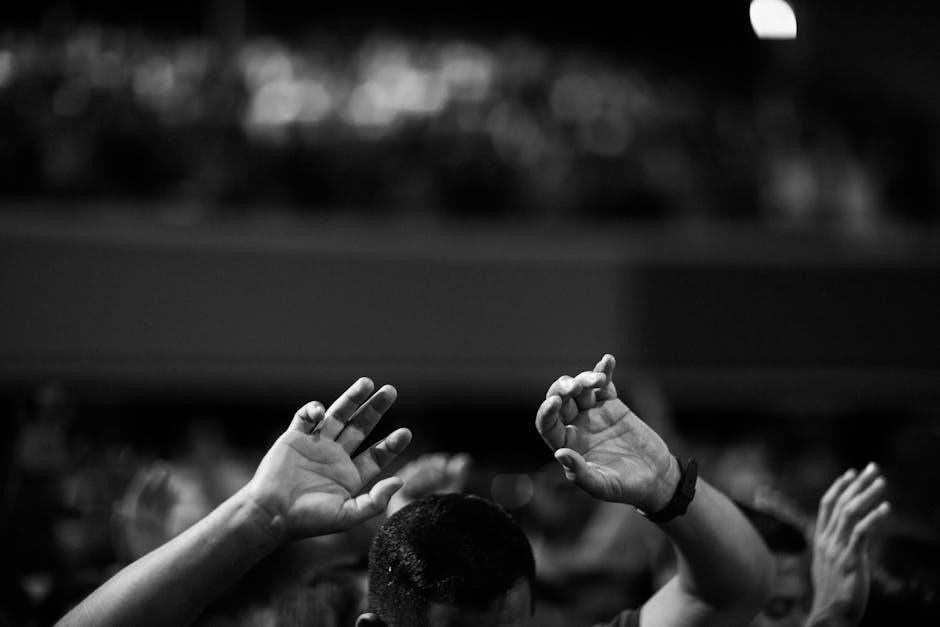why men hate going to church pdf
Recent data reveals a concerning trend: diminishing male presence within church communities, mirroring a broader national decline in religious participation․
This issue isn’t isolated; local congregations across the US, even in traditionally religious areas like Brooklyn, are experiencing this shift․
The core question isn’t simply that attendance is down, but understanding the underlying reasons driving men away from faith-based institutions․

A․ The Observed Trend: Fewer Men in Pews
Statistical analysis consistently demonstrates a noticeable decrease in male attendance at religious services across various denominations․ Barna research highlights that women consistently outpace men in weekly churchgoing, particularly within Generation X and Millennial demographics․ This isn’t a new phenomenon, but the gap appears to be widening, prompting concern among religious leaders and researchers․
Observations from areas like Brooklyn, often called the “borough of churches,” confirm this trend, with fewer men visibly participating in Sunday services․ While overall attendance has declined post-pandemic, the male drop-off seems disproportionately significant․ This isn’t simply about fewer people attending; it’s about a specific demographic becoming increasingly disconnected․ The reasons are complex, ranging from shifting cultural norms to perceived irrelevance of church teachings to modern men’s lives․
Furthermore, the influence of family tradition is waning, with fewer men attending solely due to spousal or parental expectations, indicating a more independent decision-making process regarding religious practice․
B․ Scope of the Problem: National and Local Perspectives
Nationally, religious service attendance in the United States is demonstrably declining across almost all demographic groups, with a 12% decrease recently reported․ However, the decline is not uniform; certain regions and denominations are experiencing more significant losses than others․ The Treasure Coast in Florida presents a contrasting case, showing stable or even growing attendance, suggesting localized factors play a crucial role․
Locally, the situation in Brooklyn exemplifies the challenges faced by many urban churches․ Gentrification, shifting demographics, and the enduring impact of the COVID-19 pandemic are reshaping church communities and attendance patterns․ Black churches, in particular, are navigating these changes while striving to preserve musical traditions and community bonds․
This disparity between national trends and localized experiences underscores the complexity of the issue, highlighting the need for nuanced understanding and tailored solutions․ The problem isn’t simply a national statistic; it’s a collection of local struggles․
C․ The Focus: Understanding the “Why” Behind the Decline
The central inquiry revolves around deciphering the motivations behind men’s dwindling engagement with church․ Many individuals, including personal accounts, suggest a significant disconnect between traditional church structures and the lived experiences of modern men․ This isn’t merely about a lack of interest, but a perceived lack of relevance․
Exploring the reasons requires acknowledging the impact of societal shifts, including the rise of secularism and alternative belief systems․ Furthermore, the pandemic’s disruption of habitual routines and the subsequent shift to online services have undoubtedly played a role, potentially altering long-term churchgoing habits․
Ultimately, understanding this decline necessitates moving beyond superficial explanations and delving into deeper questions about authenticity, community, and the evolving needs of men in the 21st century․ It’s about identifying what’s missing and addressing those gaps․

II․ Generational Differences in Church Attendance
Data indicates a stark contrast in male church attendance across generations, with Gen X and Millennials showing significant drops, while Gen Z presents potential for change․
A․ Gen X and Millennials: A Significant Drop in Male Participation
Research consistently demonstrates a substantial decline in church attendance among men within the Gen X and Millennial demographics․ This isn’t merely a statistical anomaly; it reflects a deeper disengagement from traditional religious structures․
Barna research highlights that across all generations, women consistently outpace men in weekly church attendance, a disparity particularly pronounced within these age groups․
Many men report a disconnect, stating they would not attend were it not for family tradition or spousal influence․ This suggests a lack of personal conviction or relevance․
Contributing factors include shifting cultural norms, a rise in secularism, and a perceived lack of authenticity within church settings․ These generations often prioritize genuine connection and experiences over inherited obligations, leading them to seek community elsewhere․
The pandemic exacerbated this trend, with many men not resuming in-person attendance post-lockdowns․
B․ Gen Z: Potential for Reversal and Emerging Trends
Interestingly, Gen Z presents a potentially contrasting trend to the decline observed in older generations․ Reports suggest a surprising possibility of a revival, with pastors and researchers noting increased engagement from this demographic․
While previous generations drifted from faith, Gen Z appears more open to exploring spirituality, albeit often outside traditional church structures․ This generation values authenticity and seeks communities aligned with their values․
Emerging trends include a desire for genuine connection and a rejection of hypocrisy․ Gen Z men are drawn to faith communities that address real-life issues and offer practical support․
However, attracting and retaining Gen Z men requires churches to adapt, embracing innovative approaches and fostering inclusive environments․ Simply replicating past methods will likely prove ineffective․ The key lies in meeting them where they are and offering something meaningful․
C․ Comparing Attendance Rates Across Generations
Data consistently demonstrates a significant disparity in church attendance rates across different generations․ Barna research highlights that women consistently outpace men in weekly attendance, a trend particularly pronounced among Gen X and Millennials․
Notably, the decline in male participation is steeper in these generations compared to older cohorts․ While older men maintained relatively stable attendance, younger men have increasingly disengaged from traditional church life․
Furthermore, a recent study indicated a 12% decline in overall religious service attendance among U․S․ adults, impacting all demographics, but disproportionately affecting men․ This suggests a broader societal shift away from organized religion․
However, the Treasure Coast region presents an anomaly, with stable or growing attendance, indicating localized variations․ Comparing these rates reveals a complex picture, influenced by factors like regional culture and community demographics․

III․ Societal Factors Contributing to the Decline
Shifting cultural norms, the rise of secularism, and gentrification’s impact on communities all contribute to dwindling male church attendance, reshaping religious landscapes․
A․ The Impact of Gentrification on Church Communities
Gentrification profoundly disrupts established church communities, particularly those historically serving minority populations, like many Black churches in Brooklyn․ As neighborhoods transform, long-time residents – often the core of these congregations – are displaced due to rising costs of living․
This displacement isn’t merely demographic; it’s a loss of social fabric and shared history․ Men, deeply rooted in these communities, may feel alienated as familiar faces disappear and the church’s character changes․ The influx of new residents, with different priorities and affiliations, can further marginalize existing members․
Furthermore, gentrification often leads to changes in local priorities, potentially diminishing the perceived relevance of the church within the evolving neighborhood; This can contribute to a sense of disconnect, particularly for men seeking community and belonging within a familiar context․ The preservation of musical traditions within these churches is also threatened․
B․ Shifting Cultural Norms and Masculinity
Evolving definitions of masculinity play a significant role in declining male church attendance․ Traditional church environments may not align with modern expressions of manhood, potentially feeling restrictive or irrelevant to men navigating contemporary societal expectations․
Many men report a disconnect between the perceived emotional openness encouraged within church settings and societal pressures to maintain stoicism and self-reliance․ This perceived dissonance can create discomfort and discourage participation․ The emphasis on traditionally feminine roles within some congregations may also contribute to this feeling of alienation․
Furthermore, a broader cultural shift towards secularism and alternative belief systems offers men different avenues for finding meaning and community, often without the perceived constraints of traditional religious institutions․ This provides alternative spaces for connection and purpose․
C․ The Rise of Secularism and Alternative Belief Systems
Increasing secularization presents a compelling alternative to traditional religious frameworks, particularly for men seeking meaning outside established institutions․ The decline in religious affiliation across demographics, as noted by Heritage Foundation analysts, reflects a broader societal trend․
Alongside secularism, the proliferation of alternative belief systems – encompassing philosophies like humanism, mindfulness, and various spiritual practices – offers men different pathways for ethical guidance and community․ These options often emphasize personal autonomy and rational inquiry, appealing to those disillusioned with traditional dogma․
This shift isn’t necessarily a rejection of spirituality, but rather a re-evaluation of where and how men seek it․ The availability of these alternatives provides a compelling reason for decreased church attendance, offering spaces perceived as more intellectually stimulating and personally relevant․

IV․ The Role of the COVID-19 Pandemic
Initial lockdowns drastically reduced in-person church attendance, and while restrictions have eased, many men haven’t resumed regular participation, altering habits․
The shift to online services, while necessary, didn’t resonate with all men, potentially exacerbating existing disengagement from church life․
A․ Initial Decline in Attendance During Lockdowns
The onset of the COVID-19 pandemic and subsequent lockdowns in 2020 triggered an immediate and substantial decline in church attendance across the United States․ Forced closures of physical church buildings meant the cessation of in-person services, impacting all demographics, but potentially disproportionately affecting men․
Many men, already less consistently engaged in religious practice than women – as evidenced by Barna research – may have found it easier to disengage entirely when faced with the logistical and social barriers of virtual attendance․ The disruption of established routines, coupled with anxieties surrounding the virus, likely contributed to this initial drop․
Furthermore, the sudden shift to online formats presented challenges for some men who valued the communal aspect of in-person worship or found the digital experience less compelling․ This initial disruption created a significant break in habit, setting the stage for longer-term changes in churchgoing behavior, as noted in recent news broadcasts․
B․ Lingering Effects on Churchgoing Habits
Even as pandemic restrictions eased, church attendance hasn’t fully rebounded to pre-2020 levels, indicating lasting shifts in habits․ Many individuals, including men, discovered alternative ways to spend their Sundays, or simply grew accustomed to the flexibility of not attending services regularly․
The initial disruption fostered a sense of detachment, and re-establishing the routine of churchgoing proved difficult for some․ This is particularly relevant given that many men, as suggested by online discussions, weren’t deeply rooted in a strong personal faith tradition to begin with, making them more susceptible to drifting away․
The convenience of online options, while initially a necessity, may have inadvertently reinforced a more passive engagement with faith, diminishing the perceived value of in-person community․ This lingering effect continues to challenge churches seeking to re-engage men and rebuild consistent attendance patterns․
C․ The Shift to Online Services and its Impact on Men
The rapid transition to online church services during the pandemic, while necessary, presented unique challenges in engaging male congregants․ Many men, already less consistently engaged than women, found the digital experience less fulfilling and connecting than in-person worship․
The lack of physical presence, communal rituals, and direct social interaction diminished the sense of belonging and accountability that often motivated attendance․ Online formats often failed to replicate the atmosphere conducive to deeper spiritual connection for many men․
Furthermore, the digital space introduced distractions and competing demands for attention, making it harder to focus on the service․ This shift potentially exacerbated existing disengagement, contributing to a continued decline in male participation even after the return to in-person gatherings․

V․ Church-Specific Factors: What Churches Might Be Doing Wrong
Churches may struggle with relevance, lacking programs addressing men’s specific needs, fostering homogenous environments, and exhibiting leadership styles that fail to resonate․
A․ Perceived Lack of Relevance to Men’s Lives
Many men feel disconnected from church life, particularly if attendance isn’t rooted in a strong family tradition․ The content often doesn’t address the challenges they face – work, finances, providing for families, or navigating modern masculinity․
Traditional church structures and messaging can appear out of touch with the realities of contemporary male experiences․ There’s a perception that churches focus heavily on issues deemed “feminine” or family-oriented, neglecting the specific needs and interests of men․
A lack of practical application of faith to daily life is also a significant factor․ Men often seek tangible solutions and guidance, and if church doesn’t offer that, they may look elsewhere for support and community․ This disconnect fuels a sense of alienation and disengagement․
Without relevant engagement, churches risk becoming perceived as irrelevant to men’s lives, contributing to the ongoing decline in male attendance․
B․ Homogenous Environments and Lack of Male Role Models
Many churches present a predominantly female demographic, particularly in leadership and visible roles․ This can create an environment where men feel out of place or that their perspectives aren’t valued․ The absence of strong, relatable male role models within the church community is a significant deterrent․
A lack of male mentorship and fellowship opportunities further exacerbates this issue․ Men often thrive in spaces where they can connect with others who share similar experiences and offer guidance․ Without these structures, they may struggle to find a sense of belonging․
Homogenous social circles can also contribute to feelings of isolation․ If a church lacks diversity in age, background, or interests, it may be difficult for men to form meaningful connections․ This can lead to disengagement and a search for community elsewhere․
Creating inclusive spaces with visible male leadership is crucial for attracting and retaining men․
C․ Issues with Church Leadership and Pastoral Approach
Perceptions of inauthenticity or a disconnect from real-world issues can alienate men from church leadership․ A pastoral approach focused solely on spiritual matters, neglecting practical life challenges, may fail to resonate with their needs․
A lack of direct, honest communication is also a contributing factor․ Men often appreciate straightforwardness and a willingness to address difficult topics openly․ Avoiding controversial issues or offering overly simplistic solutions can be perceived as disingenuous․
Leadership styles that are perceived as overly emotional or lacking in strength may not appeal to traditional masculine sensibilities․ This isn’t to suggest a rejection of empathy, but rather a preference for balanced leadership․
Churches need leaders who can authentically connect with men, offering guidance and support without judgment, fostering a sense of trust and respect․

VI․ The Importance of Family and Tradition
Family habits significantly shape religious practice, with many men attending due to spousal or parental influence; however, tradition alone isn’t enough for sustained engagement․
A․ The Influence of Family Habits on Religious Practice
Early exposure to church through family routines profoundly impacts an individual’s later religious involvement․ Data indicates many men continue attending primarily because it’s a long-held family tradition, or at the insistence of a spouse․
This is particularly evident when considering those who might not actively seek religious connection independently․ The habit of Sunday attendance, ingrained from childhood, becomes a default behavior, maintained more out of obligation than personal conviction․
However, this reliance on familial influence presents a vulnerability․ If the personal connection to faith is weak, or if the church environment fails to resonate with individual needs, the tradition can easily be abandoned․ Married fathers with children under 18 are found to be more likely to attend, suggesting family responsibility plays a key role․
Ultimately, while family habits initiate religious practice, fostering genuine personal faith is crucial for long-term engagement, especially among men․
B․ Men Who Attend Primarily Due to Spousal or Parental Influence
A significant portion of male church attendance is driven by external factors, specifically the influence of wives or parents․ This suggests a lack of intrinsic motivation for many men, attending more to support family members than through personal spiritual desire․
This dynamic can create a disconnect, where men physically present in church may not be fully engaged emotionally or intellectually․ They may feel pressured to participate in rituals without a genuine sense of belonging or purpose․
The data highlights a pattern: men who didn’t grow up with a strong personal faith, or who find the church environment unfulfilling, are more likely to attend solely due to familial expectations․ This can lead to resentment or a feeling of obligation, further distancing them from the community․
Understanding this dynamic is crucial for churches seeking to genuinely connect with and retain male members․
C․ Breaking the Cycle: When Tradition Fails to Engage
For many men, church attendance is simply a habit, a continuation of family tradition devoid of personal meaning․ However, this tradition is increasingly failing to resonate with younger generations, particularly Gen X and Millennials, leading to a significant drop in male participation․
When the foundational reasons for attending – parental expectation or social obligation – weaken, men are more likely to question the relevance of church in their lives․ Without a compelling personal connection, the routine feels empty and unfulfilling․
This break in tradition isn’t necessarily a rejection of faith, but a search for authenticity and a community that speaks to their needs․ Churches must actively address this by offering experiences that are engaging, relevant, and foster genuine connection․
Simply relying on past practices will not suffice; a proactive shift is required․

VII․ The Search for Authenticity and Community
Men crave genuine relationships and transparent environments, often finding church settings perceived as inauthentic․ They actively seek community outside traditional institutions, desiring real connection․
A․ Men’s Desire for Genuine Connection
Many men express a longing for authentic relationships, a space where vulnerability isn’t discouraged, and superficiality doesn’t reign․ This desire often goes unmet within traditional church structures, contributing to their disengagement․ The provided information suggests a disconnect; if not for family tradition, many men wouldn’t attend․
They aren’t necessarily rejecting faith itself, but rather the perceived lack of genuine camaraderie and support․ Men often seek environments where they can openly discuss challenges, share experiences, and build bonds based on mutual respect and understanding․ This need for authentic connection extends beyond simply attending a service; it encompasses small groups, mentorship opportunities, and shared activities․
The search for this authenticity drives many men to find community in other areas of life – sports leagues, hobby groups, professional networks – where they feel more accepted and understood․ Churches must actively cultivate spaces that foster genuine connection to re-engage this demographic․
B․ Perceived Lack of Authenticity in Church Settings
A significant barrier for men is the perception of inauthenticity within many church environments․ This manifests as a feeling that interactions are superficial, and genuine struggles are glossed over in favor of presenting a polished image․ Men often crave transparency and honesty, finding it difficult to connect with what feels like a curated performance of faith․
The information highlights a desire for “genuine connection,” which is hampered when churches appear to prioritize tradition over real-life relevance․ This perceived lack of authenticity can be particularly alienating for men accustomed to direct communication and practical problem-solving․ They may view church as disconnected from the realities of their daily lives․
This disconnect fosters skepticism, leading men to seek communities where vulnerability is embraced, and honesty is valued above all else․ Addressing this requires a conscious effort to create spaces where genuine emotions and struggles can be openly acknowledged and addressed․
C; Finding Community Outside of Traditional Religious Institutions
Increasingly, men are discovering fulfilling community bonds outside the confines of traditional churches․ This shift reflects a broader search for belonging and purpose, often found in spaces that align more closely with their interests and values․ These alternative communities can range from sports leagues and hobby groups to professional networks and volunteer organizations․
The desire for “genuine connection,” previously unmet within church settings, is often readily available in these environments․ Men find camaraderie through shared activities and mutual support, fostering a sense of belonging that transcends religious affiliation․ This isn’t necessarily a rejection of faith, but rather a re-prioritization of community needs․
These alternative spaces offer a sense of authenticity and shared purpose, addressing the perceived shortcomings of traditional church environments․ They provide opportunities for meaningful interaction and personal growth, fulfilling the social and emotional needs that once might have been sought within a religious context․

VIII․ Addressing the Issue: Potential Solutions
Churches must evolve, creating inclusive spaces, developing targeted programs for men, and delivering relevant content to re-engage a disconnected generation․
A․ Creating Welcoming and Inclusive Environments
Addressing the decline requires a fundamental shift in how churches present themselves․ Many men perceive a lack of authenticity and genuine connection within traditional settings, seeking spaces where vulnerability isn’t discouraged․
Inclusive environments necessitate moving beyond homogenous demographics and actively fostering diversity in leadership and membership․ This means intentionally creating opportunities for men to connect with relatable role models and participate in meaningful discussions․
Churches should prioritize dismantling perceived barriers to entry, ensuring services and programs cater to diverse interests and life stages․ This includes acknowledging and addressing the reasons men might feel disconnected, fostering a sense of belonging, and actively soliciting feedback to improve inclusivity․
Ultimately, a welcoming atmosphere isn’t about lowering standards, but about expanding the circle and demonstrating genuine care for all individuals, regardless of background or belief․
B․ Developing Programs Specifically for Men

Recognizing that men often seek different forms of engagement, churches must move beyond generalized programs and develop initiatives tailored to their specific needs and interests․ This isn’t about segregation, but about acknowledging diverse preferences․
Effective programs could focus on practical skills, outdoor activities, service projects, or discussions centered around relevant life challenges – fatherhood, career, financial responsibility, and mental health․ These should be spaces where men can build camaraderie and address issues openly․
Crucially, these programs should avoid replicating traditional “men’s ministry” stereotypes and instead prioritize authenticity and genuine connection․ They should be led by relatable men who can foster a safe and non-judgmental environment․
Investing in such initiatives demonstrates a commitment to meeting men where they are, offering opportunities for growth and community outside the confines of traditional worship services․
C․ Focusing on Relevant and Engaging Content
A key factor in attracting and retaining male attendance is delivering content that resonates with their lived experiences and addresses contemporary issues․ Many men perceive a disconnect between traditional sermons and their daily realities․
Churches should prioritize biblical teaching that is practical, applicable, and intellectually stimulating, avoiding overly sentimental or abstract messages․ Exploring themes of purpose, responsibility, and navigating a complex world can be particularly effective․
Furthermore, incorporating diverse media – videos, podcasts, real-life stories – can enhance engagement and cater to different learning styles․ Content should be presented in a concise and impactful manner, respecting men’s time and attention spans․
Ultimately, the goal is to demonstrate the relevance of faith to all aspects of life, offering guidance and encouragement for navigating challenges and living with integrity․










Leave a Comment